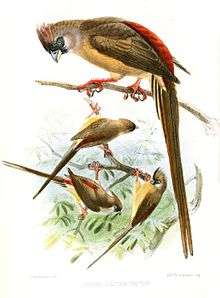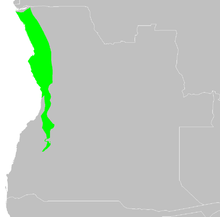Red-backed mousebird
| Red-backed mousebird | |
|---|---|
 | |
| Scientific classification | |
| Kingdom: | Animalia |
| Phylum: | Chordata |
| Class: | Aves |
| Order: | Coliiformes |
| Family: | Coliidae |
| Genus: | Colius |
| Species: | C. castanotus |
| Binomial name | |
| Colius castanotus Verreaux & Verreaux, 1855 | |
 | |
| General range: Angolan scarp savanna and woodlands | |
The red-backed mousebird (Colius castanotus) is a species of bird in the Coliidae family. It is found in Angola and the Democratic Republic of the Congo. The name mousebird is based on bird's soft feathers with texture similar to a mouse's fur. The Red-backed mousebird got its name from the red or chestnut color patch on its back.
Location and habitat
River boarders that provide water sources for vegetation like trees and bushes are the prefect ideal homes for mousebirds, their environment is located near the rivers between boarders both southern Angola and northern Namibia.[2] The Red-backed mousebird prefer less dense forests than those favorable to other mousebirds.[2] Shrubs are also favored, especially with thorns, predators away from their nest.[3] The red-backed mousebird's nest structure is characterized as "cup-like, thick and untidy state".[3]
Physical Features
Like other mousebirds, Colius castanotus possesses feathers that resembles the soft fur of a mouse, but it is notable for its red or chestnut patch on it back.[3] Its average size ranges from 11 to 15 inches and weighs around 1 to 3 ounce.[2] The red-backed mousebird is not adapted for long-distant flights. The wings of the mousebird are described as short and rounded.[3] The longevity of the red-backed mouse is 10 to 12 years.[4]
Diet
The Red-Backed Mousebird's diet consist of plants such as berries and seeds that can be consume from their environment or from the crops on farms.[2] But mousebirds tend to ruin the cultivated fields which makes them minor disruptions in maintaining frop fields. Other diet components include small animals such as insects, siders, and other vertebrates such as lizards and frogs.[3]
Behavior and Reproduction
The red-backed mousebirds are social birds living together within groups. They usually travel in flocks ranging from 6 to 24 with other mousebird groups.[5] However, they do not migrate to other locations when the temperatures get cool, unlike most common birds.[5] The average red-backed mousebird's daily routine is simple eating, drinking water, and bathing in the dust.[5] The mousebird's metabolism level is most active during the daytime.[6] The reproduction of the Red-backed Mousebird is similar to most bird families where both parents take turns incubating the eggs. Yet the parenting skills of the red-backed mousebird is different, in that they not only rely on the parents but the community as well. Other parents may help group members for example, another male may guard the nest and a female may share her nest with another female to incubate her eggs.[5] The female red-backed mousebird can only lay one egg at a time and can lay up 2 to 4 eggs.[7] The eggs are white with blackish and brownish specks.[3]
References
- ↑ BirdLife International (2012). "Colius castanotus". IUCN Red List of Threatened Species. Version 2013.2. International Union for Conservation of Nature. Retrieved 26 November 2013.
- 1 2 3 4 Hutchins, Ed. Michaels; Evans, Arthur V.; Jacksons, Jerome A.; Kleiman, Devra G.; Murphy, James B.; Thoney, Dennis A. (2004). Grzimek's Animal Life Encyclopedia Vol. 9 Birds II (2nd ed.). Detroit. pp. 469–470.
- 1 2 3 4 5 6 "Encyclopedia of Animals". Red-backed mousebird: 1. 2006.
- ↑ Schifter, Herbert (1985). "Longevity Records of Mousebirds (Coliide) in Captivity": n.
- 1 2 3 4 Judge Allen, Ed. Cathrine; Evans, Arthur V.; McDade, Melissa C.; Schlager, Neil; Mertz, Leslie A.; Harris, Madeline S. (2005). Grzimek's Student Animal Life Rescource Vol. 6 Birds: Volume 3. Detroit. pp. 639–641.
- ↑ "Journal of Ornithology". Journal of Ornithology. 125.2: 225–237. 1984. doi:10.1007/bf01640590.
- ↑ Jude Allen, Ed Cathrine; Evans, Arthur V.; McDade, Melissa C.; Schlager, Neil; Mertz, Leslie A.; Harris, Madeline S. (2005). Grzimek's Student Animal Life Resource Vol. 6 Birds: Volume 3. Detroit. pp. 639–641.
